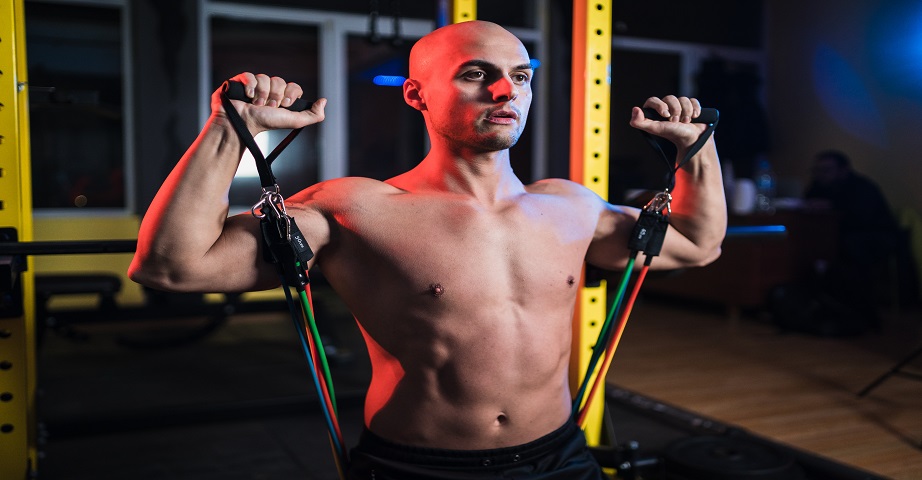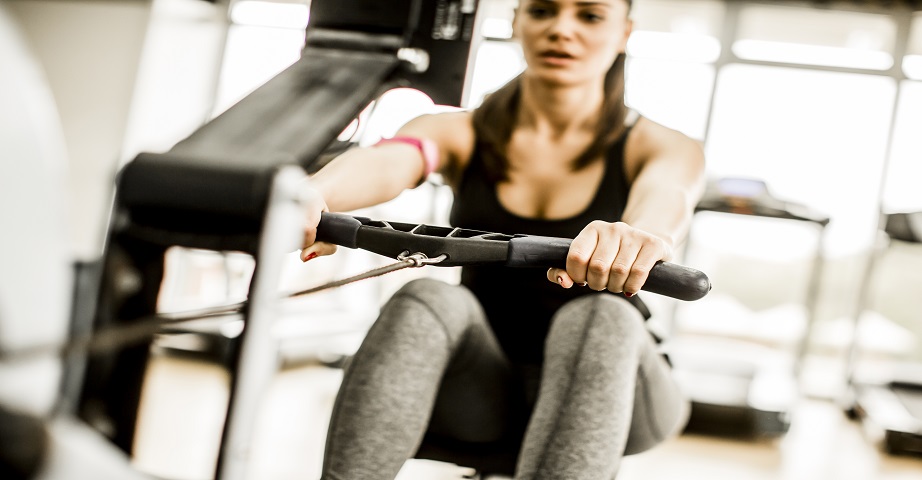Split training - what is it? What does an exemplary split training plan look like?

Split training is a type of shared training that involves performing exercises for a particular muscle part within separate training sessions. It is an effective way of shaping the figure and increasing muscle mass, which is most often used by experienced lovers of strength sports and bodybuilding. Who is split recommended for? How to combine individual muscle parts during exercise? How does split differ from full body workout and which training method is better?
Summary
Split training - what is it and what is it look like?
Split training is a training method that involves exercising each muscle part as part of separate training sessions. It is a shared training that allows for intensive stimulation of individual muscle groups, and at the same time for quick and effective development of muscle mass and shaping the figure.
Split workouts are very popular among people to attend the gym. Its frequency depends on the expected effects. However, most are often performed 3 to 6 training sessions per week.
Split gives the exerciser more time to regenerate muscles. However, although the frequency of training taking into account individual muscle parts is smaller, the volume is usually larger than in the case of other training methods, which should be paid special attention especially to beginners.
Split training - who is it recommended for?
Split training is used primarily by people who focus on silhouette sports. This is due to the fact that split allows very intense stimulation of individual muscle groups, and at the same time provides time for muscle regeneration after exercise. In addition, it is one of the better methods that helps to develop muscle mass.
All the same, split training is not for everyone. Because the volume of one training session is large, the exercise method is recommended especially for advanced people who are distinguished by a higher level of training, and the purpose of their action is to improve and strengthen weaker muscle parts and the growth of muscle mass.
The exercise model should be abandoned by beginner lovers of physical activity, because the body of a person who is just starting his adventure with sports and has not trained strength so far is not adapted to the loads, which occur during split training. Before performing physical exercise with weights, should accustom muscles to hard work, strengthen them and take care of their flexibility. Among beginners who start strength exercises with split training, it can easily and quickly occur in serious injuries and damage. What's more, in order to practice split training, you should master the technique and principles of performing several exercises for individual muscle groups, which can be especially difficult among people, which have not had to deal with a load during physical exertion so far.
How to combine muscle groups in a split?
Because split training is a shared training, the body during this exercise method should be divided into muscle parts. Can be distinguished groups, such as:
- chest,
- back,
- shoulders,
- triceps,
- biceps,
- legs.
There are several different methods of combining individual muscle groups in a split. However, you should know how to properly combine muscle parts - too frequent activation of muscles can contribute to their overtraining, while too rare stimulation of them to exercise can make that training will not be effective.
One of the solutions is to train one part of the muscles every day. Then physical exercise should be allocated 6 days a week. However, when the training goal is to increase strength, endurance and muscle mass, it may be necessary to limit training sessions to 3 or 4 per week. Then it may be obligatory to combination individual muscle groups in one session.
Most often, two methods of combining individual muscle parts are used - using synergistic actions between them or antagonistic dependences.
In order to be able to fully use the cooperation of individual muscle groups, it is necessary to know which smaller muscle part supports a particular larger group. Usually, chest training is combined with triceps exercises, and back exercises with biceps. In the case of 3 training sessions during the week, the last one usually activates the abdominal muscles, legs and shoulders. However, when the athlete performs 4 workouts a week, the abdomen is exercised together with the legs, and the shoulders - separately.
On the other hand, antagonistic connected muscles usually consists of four workouts per week - during one session you should focus on your legs, and during the next - on your chest and back. The third training should include triceps and biceps, and the fourth - shoulders and abdominal muscles.

FBW or split - which training is better?
Often can find comparisons focusing on FBW and split training - which exercise method is better?
It is worth paying attention to the fact that FBW and split are different in many ways, including different assumptions. Split training is, as we have already mentioned, shared training, which consists in shaping individual muscle parts as part of separate training sessions. It is characterized by a large volume and more time for regeneration. Split training is an exercise system that is recommended especially among advanced people who want to strengthen weaker muscle parts and develop muscle mass.
In turn, FBW, or full body workout, is a general training, which consists in exercising the whole body during one training session. Most often, muscles are strengthened as part of multi-joint exercises. The volume of exercise focused around one muscle part is small, as is the time for recovery. Thus, full body workout consists in providing the body with a small stimulus, but with a high frequency. FBW is a training method that will be great for beginners, starting the adventure with shaping the figure and building muscle mass. It is also a good type of activity for people who return to sport after a long break, related to injury or insult.
It is difficult to say which exercise method is better. Each of them is distinguished by different assumptions and can help achieve the expected goals for different people. For beginners, a full body workout may be a better solution, while for more experienced people - split.
Advantages and disadvantages of split training
Each training method has certain advantages and disadvantages. The same is true for split. What are the benefits of split exercises, and what is not necessarily their advantage?
Split advantages:
- during split training, it is more difficult to overtrain and burden the central nervous system,
- it is an effective training method that allows easy muscle development and strengthening of weaker muscle parts,
- maximum possibilities - during the split exercises, the practitioner focuses 100% on a specific muscle part, thanks to which the training performs as best as possible, with maximum power.
Split disadvantages:
- it is a training focused on shaping the figure and developing muscle mass, which is why it is not a good solution among all lovers of an active lifestyle, for example among footballers or swimmers,
- skipping one workout can disrupt the entire training plan and cause the need to make changes to the exercise schedule,
- low frequency of exercise - individual muscle parts are trained only once a week,
- large training volume and significant overloads, which makes that split can be a good training method only among advanced athletes.
How to create a split training plan?
Split training is a flexible method of exercise, which can be modified in many ways, changing the frequency of exercise, the way to combine muscle parts or the type of exercise performed. Everything depends on the training goal, which is why during creating a split plan, it is worth paying attention to individual priorities. Do you care primarily about the increase in muscle mass or sculpting the figure? Or maybe on improving endurance and increasing strength?
Specific modifications of the training plan can help achieve the expected results in a given, most interesting area of the athlete, although of course the split exercise system will have a positive effect on all of these ranges.
- Focusing on the enhancement of muscle mass, it is worth considering 3-4 training sessions and 8-16 series during the week, and perform 6 to 12 repetitions of each exercise for individual muscle groups in one series. The break time between sets should be about 2 minutes.
- In turn, during shaping the figure, it is worth increasing the frequency of training to 4 or even 6 per week and performing 12-20 series, have regard to 12 to 15 repetitions of a specific exercise in one series. The break time between the series should be shorter - about 1 minute.
- To develop strength and endurance, it is worth doing 3 workouts a week, taking into account 6-14 series and performing 8-10 repetitions of individual exercises. The break time between the series should be extended, against split training aimed at other purposes, and should be about 3-4 minutes.
In addition, when doing split training, it is worth basing on free weights, using, among others, barbells and griffins, which will allow the practitioner to train in the full range of motion and strengthen the deep sensibility. In addition, it is worth trying to arrange a training plan so that large muscle groups are combined with smaller muscle parts during one training session.

4-day split training
An example of a split training taking into account four training series during the week may look as follows:
- Day 1 - legs - exercises such as deadlift with dumbbells, deadlift on straight legs, leg press, lunges,
- Day 2 - rest day,
- Day 3 - chest and back - exercises such as chest fly, barbell bench press, push-ups on one hand, bent over dumbbells row, cable pullover
- Day 4 - rest day,
- Day 5 - triceps and biceps - exercises such as EZ bar biceps curls, dips on the railings, French over head press while sitting, reverse barbell biceps curl,
- Day 6- rest day,
- Day 7 - shoulders and abdomen - exercises such as, for example, torso bends on the machine, lateral bends with dumbbells standing, russian twist, behind the neck overhead press, lateral raise with dumbbells.
3-days split training
An example training plan including three workouts a week can be look as follows:
- Day 1 - chest and triceps - exercises such as Smith bench press on a positive bench, bench press from the ground, chest fly on a butterfly machine, skull crushers, impossible dip,
- Day 2 - rest day,
- Day 3 - back and biceps - exercises such as low cable rope curl while lying, barbell biceps curl, sumo deadlift, shrugs with dumbbells,
- Day 4 - rest day,
- Day 5 - Day 5 - shoulders, abdomen, legs - exercises such as, for example, landmine press, raising the arm to the side with pull links standing, Romanian deadlift, american swing, candlestick exercise on the negative bench, farmer's walk,
- Day 6 - rest day,
- Day 7 - rest day.

